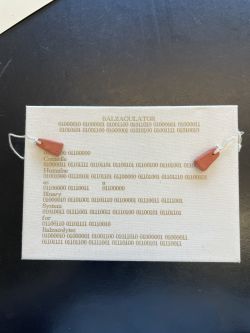Balzaculator : la Comédie humaine as a binary system for Balzacolytes

Balzaculator : la Comédie humaine as a binary system for Balzacolytes is an artist book created by American book artist Angela Lorenz in 2013. It feature characters created by French novelist and playwright Honoré de Balzac in his work, La Comédie humaine. Besides the tribulation to Balzac, the artist book also pays homage to Joseph Marie Charles for his role in the institution of the first programmable loom around the time of Balzac's birth through the usage of Jacquard punched cards to showcase the traits of the characters.[1]
Like most artists' books, the Balzaculator is limited in copies with only 33 editions ever created. A copy of this book was acquired by the University of Pennsyvlania's Van Pelt Library through the donations of Ruth and Marvin Sackner Fund and Samuel P. Orlando Fund in 2014
About the Author

Angela Lorenz was born in Boston, Massachusetts in 1955. She attended from Brown University, majoring in Fine Art and Semiotics and graduated in 1987. She currently lives in Bologna, Italy, where she creates most of her artists' books.
Her work focuses on material culture, visual culture and language, expressing them through watercolors, prints, multiples, mosaics and artist’s books. There are over 100 different collections across the world that feature her creations, including exhibitions at he Metropolitan Museum of Art, the National Gallery of Art, The British Library, and the Library of Congress.[2]
In 2019, Lorenz was awarded the prize for Outstanding Contribution to the Art of the Book by Center for Book Arts, New York.[3]
Historical Significance
Joseph Marie Jacquard was a French weaver and merchant who lived during the Napoleonic era. Jacquard invented the Jacquard mechanism 1801, to which it simplified how textile patterns were woven. The machine features thousands of punch cards laced together, allowing for greater efficiency in the weaving process while producing patterns with almost unlimited complexity.
- ↑ Angelonium: 76. Balzaculator https://angelonium.com/76-balzaculator/ /
- ↑ Angela Lorenz Artists Books http://www.angelalorenzartistsbooks.com/
- ↑ Maine Media: Angela Lorenz https://www.mainemedia.edu/faculty/list/angela-lorenz/